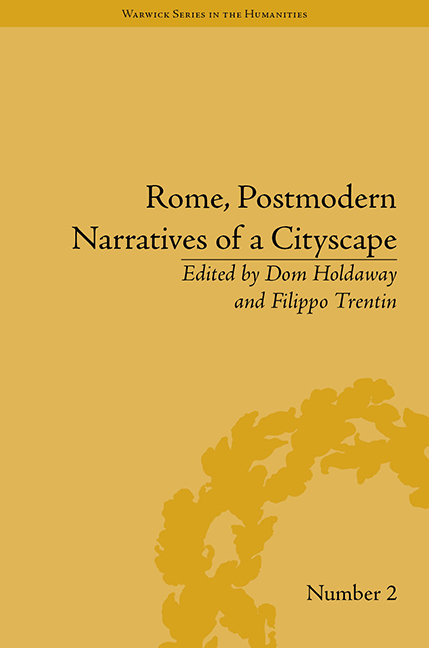Book contents
- Frontmatter
- Contents
- Acknowledgements
- List of Contributors
- List of Figures
- Introduction: Rome, Postmodern Narratives of a Cityscape
- Part I Knowing Rome
- Part II Fragmented Topography
- 4 Topophilia and Other Roman Perversions: On Bertolucci's La luna
- 5 Marcus Aurelius and the Ara Pacis: Notes on the Notion of ‘Origin’ in Contemporary Rome
- 6 A Postmodern Gaze on the Gasometer
- Part III Situating Rome
- Notes
- Index
6 - A Postmodern Gaze on the Gasometer
from Part II - Fragmented Topography
- Frontmatter
- Contents
- Acknowledgements
- List of Contributors
- List of Figures
- Introduction: Rome, Postmodern Narratives of a Cityscape
- Part I Knowing Rome
- Part II Fragmented Topography
- 4 Topophilia and Other Roman Perversions: On Bertolucci's La luna
- 5 Marcus Aurelius and the Ara Pacis: Notes on the Notion of ‘Origin’ in Contemporary Rome
- 6 A Postmodern Gaze on the Gasometer
- Part III Situating Rome
- Notes
- Index
Summary
A colossal piece of industrial architecture, Rome's ‘gasometro’ (gas holder, or gasometer) stands out as a dissonant element on a skyline of historic cupolas and ancient ruins – the emblems of a long-lived and powerful urban civilization. Sited adjacent to the Tiber River, beyond the Aurelian Walls in the Ostiense area, its height, girth and location endow this geometric cage with an iconic status in a cityscape devoid by law of skyscrapers (see Figure 6.1 on p. 120). Built in 1937, the circular metal tower has been invested, in the context of the larger gas factory or in depictions of the isolated structure, with evolving cultural significations: photographic, artistic, filmic and literary representations of this Roman landmark have detailed its birth, expansion, fall into ruin. The latter occured when the edifice no longer stored gas and lost its mechanical functional by the mid-1960s. By the 1990s, urban renewal in the Ostiense zone endowed the building with new symbolic meanings as it came to stand metonymically for the ‘ex-industrial’ area and era. The building established itself firmly in the collective memory of architects and Roman citizens alike as a sign of ‘the contradictions that characterized urban development’. This chapter focuses on a selection of emblematic paintings and literary works in order to bring into focus the gasometer's iconic status while at the same time it asks two questions central to a longitudinal approach. First, what features and meanings might be forgotten or bracketed in evolving representations?
- Type
- Chapter
- Information
- Rome, Postmodern Narratives of a Cityscape , pp. 119 - 136Publisher: Pickering & ChattoFirst published in: 2014



